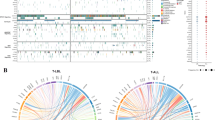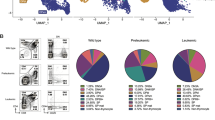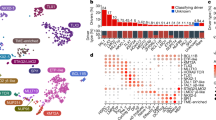Abstract
T-cell acute lymphoblastic leukemia (T-ALL) is an aggressive hematological disease originating from the malignant transformation of T-cell progenitors, caused by the accumulation of genetic aberrations. One-fifth of T-ALL patients are characterized by ectopic expression of the homeobox transcription factor TLX3. However, the role of TLX3 in T-ALL remains elusive, partly due to the lack of suitable study models. Strikingly, this TLX3-positive subgroup has a high frequency of FLT3 mutations, predominantly FLT3-ITD, in pediatric cases. To investigate this, we generated ex vivo cultured pro-T cells driven by the co-expression of TLX3 and FLT3-ITD, which conferred IL7 independent growth. This model allowed us to confirm that TLX3 expression and FLT3 signaling cooperate to transform T-cells and induce an oncogenic context. Data from this cell model, combined with gene expression data from TLX3 positive T-ALL cases, revealed a strong downregulation of the transcriptional repressor TLE4. Furthermore, TLE4 showed to have a repressive effect on ex vivo TLX3 T-ALL cell growth, likely caused by a partial reversal of the TLX3 transcriptional profile. In conclusion, we developed a TLX3+FLT3-ITD pro-T cell model and used it to illustrate that TLX3 directly represses TLE4 expression, which is beneficial for the oncogenic function of TLX3.

This is a preview of subscription content, access via your institution
Access options
Subscribe to this journal
Receive 12 print issues and online access
$259.00 per year
only $21.58 per issue
Buy this article
- Purchase on SpringerLink
- Instant access to full article PDF
Prices may be subject to local taxes which are calculated during checkout




Similar content being viewed by others
Data availability
Raw RNA-seq and ChIP-seq data performed during this study can be obtained from GSE241640.
References
Girardi T, Vicente C, Cools J, De Keersmaecker K. The genetics and molecular biology of T-ALL. Blood. 2017;129:1113–23. Mar 2
MacLeod RAF, Nagel S, Kaufmann M, Janssen JWG, Drexler HG. Activation of HOX11L2 by juxtaposition with 3’-BCL11B in an acute lymphoblastic leukemia cell line (HPB-ALL) with t(5;14)(q35;q32.2). Genes Chromosomes Cancer. 2003;37:84–91. May 1
Cheng L, Samad OA, Xu Y, Mizuguchi R, Luo P, Shirasawa S, et al. Lbx1 and Tlx3 are opposing switches in determining GABAergic versus glutamatergic transmitter phenotypes. Nat Neurosci. 2005;8:1510–5. Nov
Smits WK, Vermeulen C, Hagelaar R, Kimura S, Vroegindeweij EM, Buijs-Gladdines JGCAM, et al. Elevated enhancer-oncogene contacts and higher oncogene expression levels by recurrent CTCF inactivating mutations in acute T cell leukemia. Cell Rep. 2023;42:112373.
Botten GA, Zhang Y, Dudnyk K, Kim YJ, Liu X, Sanders JT, et al. Structural variation cooperates with permissive chromatin to control enhancer hijacking-mediated oncogenic transcription. Blood. 2023;142:336–51.
Göös H, Kinnunen M, Salokas K, Tan Z, Liu X, Yadav L, et al. Human transcription factor protein interaction networks. Nat Commun. 2022;13:766.
Dadi S, Le Noir S, Payet-Bornet D, Lhermitte L, Zacarias-Cabeza J, Bergeron J, et al. TLX homeodomain oncogenes mediate T cell maturation arrest in T-ALL via interaction with ETS1 and suppression of TCRα gene expression. Cancer Cell. 2012;21:563–76.
Shimomura A, Patel D, Wilson SM, Koehler KR, Khanna R, Hashino E. Tlx3 promotes glutamatergic neuronal subtype specification through direct interactions with the chromatin modifier CBP. PLoS ONE. 2015;10:10.
Renou L, Boelle P, Deswarte C, Spicuglia S, Benyoucef A, Calvo J, et al. Homeobox protein TLX3 activates miR-125b expression to promote T-cell acute lymphoblastic leukemia. Blood Adv. 2017;1:733–47.
Jennings BH, Ish-Horowicz D. The Groucho/TLE/Grg family of transcriptional co-repressors. Genome Biol. 2008;9:205.
Palaparti A, Baratz A, Stifani S. The Groucho/transducin-like enhancer of split transcriptional repressors interact with the genetically defined amino-terminal silencing domain of histone H3. J Biol Chem. 1997;272:26604–10.
Chen G, Fernandez J, Mische S, Courey AJ. A functional interaction between the histone deacetylase Rpd3 and the corepressor groucho in Drosophila development. Genes Dev. 1999;13:2218–30.
Yu X, Li P, Roeder RG, Wang Z. Inhibition of androgen receptor-mediated transcription by amino-terminal enhancer of split. Mol Cell Biol. 2001;21:4614–25.
Daniels DL, Weis WI. Beta-catenin directly displaces Groucho/TLE repressors from Tcf/Lef in Wnt-mediated transcription activation. Nat Struct Mol Biol. 2005;12:364–71.
Cai Y, Brophy PD, Levitan I, Stifani S, Dressler GR. Groucho suppresses Pax2 transactivation by inhibition of JNK-mediated phosphorylation. EMBO J. 2003;22:5522–9. Oct 15
Riz I, Lee HJ, Baxter KK, Behnam R, Hawley TS, Hawley RG. Transcriptional activation by TLX1/HOX11 involves Gro/TLE corepressors. Biochem Biophys Res Commun. 2009;380:361. Mar 6
Liu Y, Easton J, Shao Y, Maciaszek J, Wang Z, Wilkinson MR, et al. The genomic landscape of pediatric and young adult T-lineage acute lymphoblastic leukemia. Nat Genet. 2017;49:1211–8.
Touzart A, Mayakonda A, Smith C, Hey J, Toth R, Cieslak A, et al. Epigenetic analysis of patients with T-ALL identifies poor outcomes and a hypomethylating agent-responsive subgroup. Sci Transl Med. 2021;13:eabc4834.
Bornschein S, Demeyer S, Stirparo R, Gielen O, Vicente C, Geerdens E, et al. Defining the molecular basis of oncogenic cooperation between TAL1 expression and Pten deletion in T-ALL using a novel pro-T-cell model system. Leukemia. 2018;32:941.
Palomero T, Wei KL, Odom DT, Sulis ML, Real PJ, Margolin A, et al. NOTCH1 directly regulates c-MYC and activates a feed-forward-loop transcriptional network promoting leukemic cell growth. Proc Natl Acad Sci USA. 2006;103:18261–6.
Bonnet M, Loosveld M, Montpellier B, Navarro JM, Quilichini B, Picard C, et al. Posttranscriptional deregulation of MYC via PTEN constitutes a major alternative pathway of MYC activation in T-cell acute lymphoblastic leukemia. Blood. 2011;117:6650–9.
Herranz D, Ambesi-Impiombato A, Palomero T, Schnell SA, Belver L, Wendorff AA, et al. A NOTCH1-driven MYC enhancer promotes T cell development, transformation and acute lymphoblastic leukemia. Nat Med. 2014;20:1130–7.
Staal FJT, Weerkamp F, Langerak AW, Hendriks RW, Clevers HC. Transcriptional control of t lymphocyte differentiation. Stem Cells. 2001;19:165–79.
Zhang Y, Qian JJ, Zhou YL, Huang X, Li JH, Li XY, et al. Comparison of early T-cell precursor and non-ETP subtypes among 122 Chinese adults with acute lymphoblastic leukemia. Front Oncol. 2020;10:1423.
Van Thillo Q, De Bie J, Seneviratne JA, Demeyer S, Omari S, Balachandran A, et al. Oncogenic cooperation between TCF7-SPI1 and NRAS(G12D) requires β-catenin activity to drive T-cell acute lymphoblastic leukemia. Nat Commun. 2021;12:4164.
Brady SW, Roberts KG, Gu Z, Shi L, Pounds S, Pei D, et al. The genomic landscape of pediatric acute lymphoblastic leukemia. Nat Genet. 2022;54:1376–89.
de Bock CE, Demeyer S, Degryse S, Verbeke D, Sweron B, Gielen O, et al. HOXA9 cooperates with activated JAK/STAT signaling to drive leukemia development. Cancer Discov. 2018;8:616–31.
Thielemans N, Demeyer S, Mentens N, Gielen O, Provost S, Cools J. TAL1 cooperates with PI3K/AKT pathway activation in T-cell acute lymphoblastic leukemia. Haematologica. 2022;107:2304–17.
Tsherniak A, Vazquez F, Montgomery PG, Weir BA, Kryukov G, Cowley GS, et al. Defining a cancer dependency map. Cell. 2017;170:564–576.e16.
Coustan-Smith E, Mullighan CG, Onciu M, Behm FG, Raimondi SC, Pei D, et al. Early T-cell precursor leukaemia: a subtype of very high-risk acute lymphoblastic leukaemia. Lancet Oncol. 2009;10:147–56.
Copley RR. The EH1 motif in metazoan transcription factors. BMC Genom. 2005;6:169.
Shimeld SM. A transcriptional modification motif encoded by homeobox and fork head genes. FEBS Lett. 1997;410:124–5.
Gehre N, Nusser A, von Muenchow L, Tussiwand R, Engdahl C, Capoferri G, et al. A stromal cell free culture system generates mouse pro-T cells that can reconstitute T-cell compartments in vivo. Eur J Immunol. 2015;45:932–42.
Schmidl C, Rendeiro AF, Sheffield NC, Bock C. ChIPmentation: fast, robust, low-input ChIP-seq for histones and transcription factors. Nat Methods. 2015;12:963–5.
Acknowledgements
We thank Dr Thomas Müller from the Max-Delbrück-Centrum of Molecular Medicine (MDC) in Berlin for kindly providing us with the custom made TLX3 antibody. We thank the VIB flow cytometry core and KU Leuven genomics core for the support in processing the data obtained during this study. The graphical abstract was created using BioRender.com. This work was supported by a FWO fellowship to QVT, a postdoctoral fellowship to SD by the Foundation against Cancer, a postdoctoral FWO fellowship to AV, and a research grant by FWO to JC.
Author information
Authors and Affiliations
Contributions
LL and QVT designed and performed experiments, analyzed and interpreted data; NM, SP, OG, LB, and KJ performed experiments; SD performed bioinformatics analyses; AV and JC jointly coordinated the study; CDB involved in scientific discussions and review of the manuscript; GA and VA provided T-ALL adult patient data from GRAALL03/05 and were involved in scientific discussions; LL, QVT, and AV wrote the manuscript. All authors critically read and contributed to the final version of the manuscript.
Corresponding authors
Ethics declarations
Competing interests
This work was supported by a FWO fellowship to QVT, a postdoctoral fellowship to SD by the Foundation against Cancer, a postdoctoral fellowship to AV by the FWO, and a research grant by FWO to JC.
Additional information
Publisher’s note Springer Nature remains neutral with regard to jurisdictional claims in published maps and institutional affiliations.
Supplementary information
Rights and permissions
Springer Nature or its licensor (e.g. a society or other partner) holds exclusive rights to this article under a publishing agreement with the author(s) or other rightsholder(s); author self-archiving of the accepted manuscript version of this article is solely governed by the terms of such publishing agreement and applicable law.
About this article
Cite this article
Lauwereins, L., Van Thillo, Q., Demeyer, S. et al. TLE4 is a repressor of the oncogenic activity of TLX3 in T-cell acute lymphoblastic leukemia. Leukemia 39, 568–576 (2025). https://doi.org/10.1038/s41375-025-02513-w
Received:
Revised:
Accepted:
Published:
Issue date:
DOI: https://doi.org/10.1038/s41375-025-02513-w



